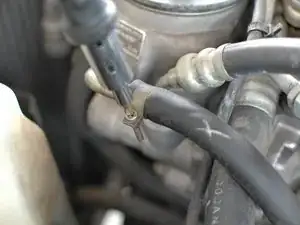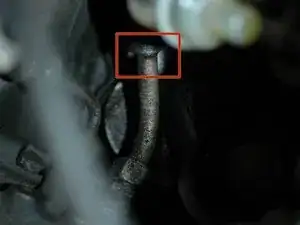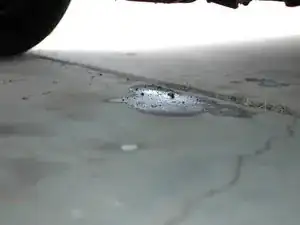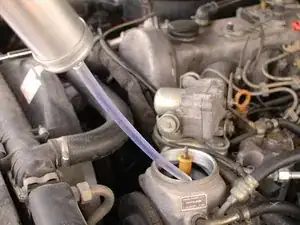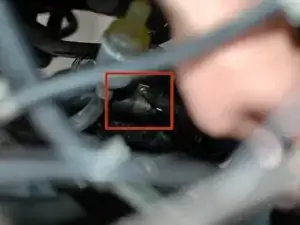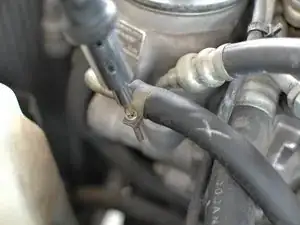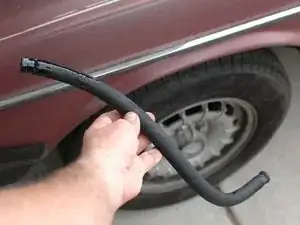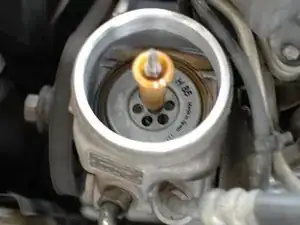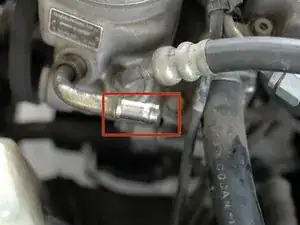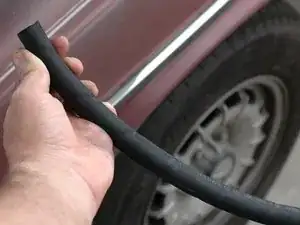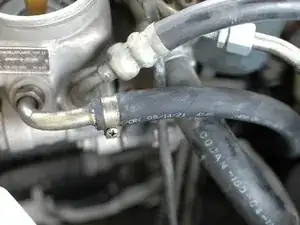Introduction
While the high pressure line in the power steering is a special order part, the low pressure side is a simple hose that can be replaced by just removing a few hose clamps. Don't put it off, power steering fluid will make a mess of your engine mount on that side of the car, and your driveway!
Tools
Parts
-
-
See the power steering low pressure hose where it connects to the steering box? It is wet with weeping fluid, and you can see that the metal hard line and the motor mount heat shield below it are oily and dirty.
-
These are telltale signs of a leaking low pressure hose. There was no hole or crack in this line - it was weeping internally out through the wall of the line.
-
-
-
A power steering leak can be tricky to identify at at least initially. Depending on the type you use, it can be red, like transmission fluid. Or it can be clear, and seem like coolant.
-
One way to help identify it is the location of the drips. When your low pressure line leaks, it tends to drip down on to the driver's side motor mount heat shield. From there, it runs down the mount and on to the cross-member that runs under the engine. Eventually, it drips down at the center of this cross-member.
-
-
-
It's time to being the repair! Begin by removing the cover on your power steering fluid reservoir.
-
-
-
Next, extract as much fluid from the reservoir as possible to limit how much fluid leaks from the low pressure hose when you remove it.
-
Still, put a drip pan under the low point on the engine cross-member to catch any fluid that is still in the reservoir as it runs out of the low pressure line.
-
-
-
Next, loosen the hose clamp on the lower side of the low pressure hose down at the steering gear box. It's just below where you usually will find your primary fuel filter.
-
Once the clamp is loose, pull the line off of the nipple it connects to. Some fluid will likely run out.
-
-
-
Now loosen the hose clamp on the upper end of the hose by the power steering fluid reservoir.
-
Pull off this end of the hose as well.
-
Here you can see the old hose. It was stiff with age, and as you can see quite wet at one end from weeping for the last few weeks.
-
-
-
Your reservoir will now be empty. If it is due, now is a great time to change the power steering filter.
-
Check and if necessary clean the two nipples where the low side hose connects.
-
-
-
Inspect the hose clamps and clean or replace them as needed. These clamps were in good shape and were re-used.
-
-
-
Slip the clamps over the new hose.
-
Then install the new hose fully over both of the connections - one at the power steering pump reservoir and the other down at the steering box.
-
Tighten the clamps to finish the installation.
-
At this time you may want to consider using some de-greaser to clean up the driver's side motor mount and the engine cross-member as they will be covered in power steering fluid. The oil may lead to premature failure of that motor mount, in particular.
-
After your first short drive check the fluid in your power steering reservoir to see if it needs to be topped off.
7 comments
Pretty good Tech Tip .
It's _VERY_ important to change the power steering fluid any time it's not red color or sweet smelling .
If it's brown or you can't see through it , change it every oil change until it remians translucent ~ failure to do so will cause pum leaks or failure .
Use ATF , _never_ power steering fluid .
-Nate
vwnate1 -
Please share some reasoning and evidence behind your statement about never using power steering fluid.
Thank you for this. I think this is my problem, and it's a relief, since I thought it was a transmission leak.
Two questions: 1) Any reason I have to have the braided hose if the psi rating is the same? The braided hose is much more expensive. 2) What size is the hose? You don't mention and I have to order it. (Your link on this page to buy the hose doesn't go anywhere.) Autozone's website thinks it's 7/16 or 9/16, yet the forums I looked at think it's 12mm.
Thank you.
I can't speak to braided vs. not braided. I think the single layer braid on the outside is for abrasion resistance. I imagine a hose rated for oil and for the correct pressure would be OK but you'll have to use your judgement as all I've tried is the genuine stuff.
If it were me, now, I'd probbaly buy this:
